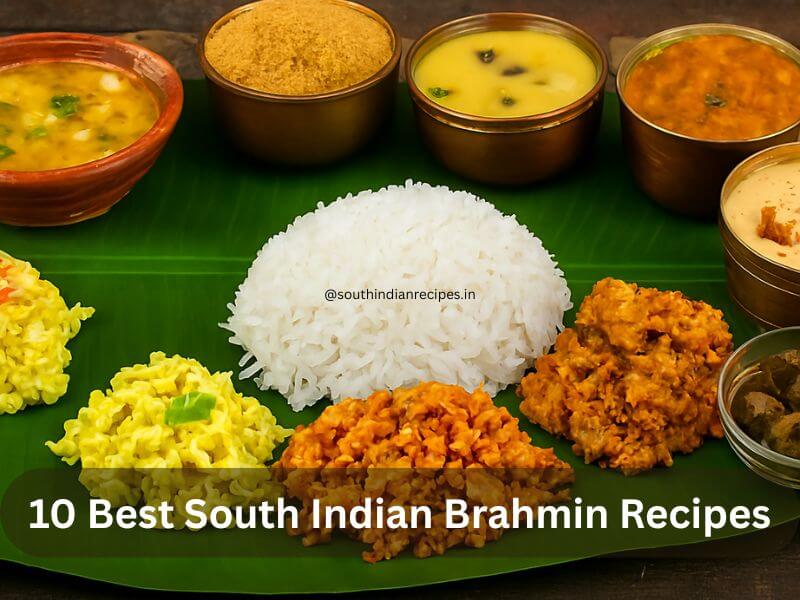South Indian Brahmin cuisine is a treasure trove of flavors, traditions, and wholesome vegetarian goodness. Known for its no-onion, no-garlic approach, this cuisine focuses on fresh vegetables, lentils, coconut, and aromatic spices — all prepared in a way that’s both Satvik (pure) and deeply satisfying.
Contents
- 🥥 What Makes South Indian Brahmin Cuisine Unique?
- 🍛 Must-Try South Indian Brahmin Recipes
- 📸 Serving & Presentation Tips
- Frequently Asked Questions (FAQs) on South Indian Brahmin Recipes
- Que 1. What is unique about South Indian Brahmin cuisine?
- Que 2. Why are onion and garlic avoided in Brahmin cooking?
- Que 3. Are all South Indian Brahmin recipes gluten-free?
- Que 4. What are some must-have ingredients for Brahmin cooking?
- Que 5. Can I make these recipes without a traditional South Indian kitchen setup?
- Que 6. Are these recipes suitable for festivals and poojas?
- Que 7. How can I make these dishes healthier?
- Que 8. What is the best way to serve a traditional Brahmin meal?
- Que 9. Can I store these dishes for later?
- Que 10. Where can I find authentic recipes online?
- 📌 Pro Tip for Home Cooks
🥥 What Makes South Indian Brahmin Cuisine Unique?
- Satvik Principles: Avoids onion, garlic, and certain root vegetables during specific rituals.
- Balanced Nutrition: Combines proteins (dal), carbs (rice), and micronutrients (vegetables, coconut).
- Ritual Connection: Many dishes are tied to festivals, weddings, and temple offerings.
- Minimal Oil Cooking: Focus on steaming, boiling, and light sautéing.
🍛 Must-Try South Indian Brahmin Recipes
1. Arachuvitta Sambar

A tangy, aromatic sambar made with freshly ground coconut, coriander seeds, and red chilies. Image suggestion: Close-up of steaming sambar in a traditional brass vessel.
2. Avial

A medley of vegetables cooked in coconut and yogurt, seasoned with curry leaves. Image suggestion: Avial served on a banana leaf alongside steamed rice.
3. Paruppu Podi

A spiced lentil powder that transforms plain rice into a comforting meal when mixed with ghee. Image suggestion: Small bowl of golden-brown podi with a dollop of ghee.
4. Mor Kuzhambu

A buttermilk-based curry with ash gourd or okra, mildly spiced and soul-soothing.
5. Vatha Kuzhambu

A tamarind-based gravy with sun-dried berries (sundakkai) or vegetables, perfect with hot rice.
6. Brahmin-Style Vegetable Kurma

A coconut-based curry without onion or garlic, loaded with carrots, beans, and potatoes.
7. Puliyodharai (Tamarind Rice)

A temple-style tangy rice dish with roasted sesame and tamarind paste.
8. Cabbage Poriyal

A simple stir-fry with coconut, green chilies, and curry leaves.
9. Vadu Mango Pickle

A traditional baby mango pickle that can last for months.
10. Payasam (Kheer)

A sweet ending — made with jaggery, coconut milk, or milk, and flavored with cardamom.
📸 Serving & Presentation Tips
- Serve on a banana leaf for authenticity.
- Arrange dishes in a Kalyana Sapadu (wedding feast) style.
- Use brass or earthenware bowls for a rustic touch.
Frequently Asked Questions (FAQs) on South Indian Brahmin Recipes
Que 1. What is unique about South Indian Brahmin cuisine?
Ans: South Indian Brahmin cuisine is strictly vegetarian and often follows Satvik principles, avoiding onion, garlic, and certain root vegetables. It emphasizes fresh produce, lentils, coconut, and mild yet aromatic spices, resulting in light, wholesome meals.
Que 2. Why are onion and garlic avoided in Brahmin cooking?
Ans: Traditionally, onion and garlic are considered Tamasic (believed to increase lethargy) in Ayurveda and are avoided during religious rituals and daily cooking in many Brahmin households to maintain purity and mental clarity.
Que 3. Are all South Indian Brahmin recipes gluten-free?
Ans: Not all, but many are naturally gluten-free since rice, lentils, and vegetables form the base. However, some dishes may include wheat-based items like chapati or certain sweets, so substitutions may be needed for a gluten-free diet.
Que 4. What are some must-have ingredients for Brahmin cooking?
Ans:
- Fresh curry leaves 🌿
- Tamarind pulp
- Coconut (fresh or grated) 🥥
- Toor dal (pigeon peas)
- Mustard seeds
- Asafoetida (hing)
- Dried red chilies
- Jaggery
Que 5. Can I make these recipes without a traditional South Indian kitchen setup?
Ans: Absolutely! While a wet grinder or idli steamer is traditional, you can adapt recipes using a blender, pressure cooker, or instant pot without losing much authenticity.
Que 6. Are these recipes suitable for festivals and poojas?
Ans: Yes — in fact, many of them like Puliyodharai, Payasam, and Vatha Kuzhambu are staples in temple offerings and festive spreads.
Que 7. How can I make these dishes healthier?
Ans:
- Use minimal oil and opt for cold-pressed sesame or coconut oil.
- Increase vegetable portions in curries and poriyals.
- Reduce salt and jaggery slightly without compromising taste.
Que 8. What is the best way to serve a traditional Brahmin meal?
Ans: Serve on a banana leaf with rice in the center, sambar and kuzhambu on one side, poriyal and kootu on the other, and payasam at the top. Always start with a small serving of paruppu (dal) and ghee.
Que 9. Can I store these dishes for later?
Ans: Most curries and podis can be refrigerated for 2–3 days. Tamarind-based gravies like Vatha Kuzhambu actually taste better the next day. Fresh coconut-based dishes like Avial are best consumed the same day.
Que 10. Where can I find authentic recipes online?
Ans: Trusted sources include traditional cooking blogs, temple kitchen recipe books, and family-run YouTube channels that focus on Tamil, Iyer, Iyengar, and Andhra Brahmin cooking styles.
Also Read: Overlooked, But Delicious South Indian Recipes Without Onion and Garlic
📌 Pro Tip for Home Cooks
If you’re new to Brahmin cooking, start with Paruppu Podi and Mor Kuzhambu — they’re easy, quick, and instantly transport you to a Tamil Brahmin household.







